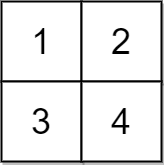2033. Minimum Operations to Make a Uni-Value Grid


Description
You are given a 2D integer grid of size m x n and an integer x. In one operation, you can add x to or subtract x from any element in the grid.
A uni-value grid is a grid where all the elements of it are equal.
Return the minimum number of operations to make the grid uni-value. If it is not possible, return -1.
Example 1:

Input: grid = [[2,4],[6,8]], x = 2 Output: 4 Explanation: We can make every element equal to 4 by doing the following: - Add x to 2 once. - Subtract x from 6 once. - Subtract x from 8 twice. A total of 4 operations were used.
Example 2:

Input: grid = [[1,5],[2,3]], x = 1 Output: 5 Explanation: We can make every element equal to 3.
Example 3:

Input: grid = [[1,2],[3,4]], x = 2 Output: -1 Explanation: It is impossible to make every element equal.
Constraints:
m == grid.lengthn == grid[i].length1 <= m, n <= 1051 <= m * n <= 1051 <= x, grid[i][j] <= 104
Solution
minimum-operations-to-make-a-uni-value-grid.py
class Solution:
def minOperations(self, grid: List[List[int]], x: int) -> int:
A = []
for row in grid:
A += row
n = len(A)
A.sort()
for i in range(1, n):
if (A[i] - A[i - 1]) % x != 0:
return -1
def go(target):
count = 0
for v in A:
count += (abs(v - target)) // x
return count
mid = n // 2
return go(A[mid]) if n & 1 else min(go(A[mid - 1]), go(A[mid]))